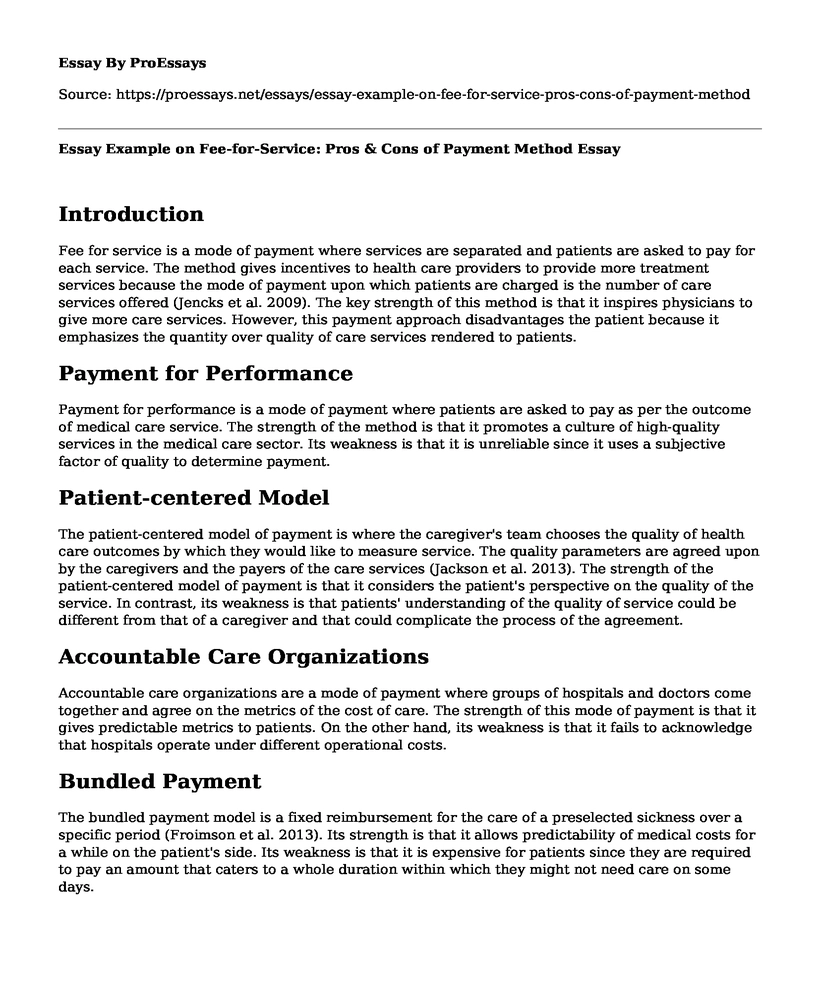Introduction
Fee for service is a mode of payment where services are separated and patients are asked to pay for each service. The method gives incentives to health care providers to provide more treatment services because the mode of payment upon which patients are charged is the number of care services offered (Jencks et al. 2009). The key strength of this method is that it inspires physicians to give more care services. However, this payment approach disadvantages the patient because it emphasizes the quantity over quality of care services rendered to patients.
Payment for Performance
Payment for performance is a mode of payment where patients are asked to pay as per the outcome of medical care service. The strength of the method is that it promotes a culture of high-quality services in the medical care sector. Its weakness is that it is unreliable since it uses a subjective factor of quality to determine payment.
Patient-centered Model
The patient-centered model of payment is where the caregiver's team chooses the quality of health care outcomes by which they would like to measure service. The quality parameters are agreed upon by the caregivers and the payers of the care services (Jackson et al. 2013). The strength of the patient-centered model of payment is that it considers the patient's perspective on the quality of the service. In contrast, its weakness is that patients' understanding of the quality of service could be different from that of a caregiver and that could complicate the process of the agreement.
Accountable Care Organizations
Accountable care organizations are a mode of payment where groups of hospitals and doctors come together and agree on the metrics of the cost of care. The strength of this mode of payment is that it gives predictable metrics to patients. On the other hand, its weakness is that it fails to acknowledge that hospitals operate under different operational costs.
Bundled Payment
The bundled payment model is a fixed reimbursement for the care of a preselected sickness over a specific period (Froimson et al. 2013). Its strength is that it allows predictability of medical costs for a while on the patient's side. Its weakness is that it is expensive for patients since they are required to pay an amount that caters to a whole duration within which they might not need care on some days.
Global Budget
The global budget is a cost metric for care services agreed upon worldwide. The strength of this mode of payment is uniformity across the world. However, the method does not uniformly consider all cost factors health caregivers incur in different parts of the world to provide care.
Payment Mode Activity
A 28-year-old with poorly controlled diabetes: the most appropriate model of payment is paying for performance. Paying for performance fits this situation because it is based on the metric of quality, and good quality service would help improve the poorly controlled diabetes condition.
An elderly individual with multiple chronic conditions: The best payment mode for this situation is the bundled payment method. Caring for multiple conditions will be relatively cheaper when there is a fixed cost for some of the conditions.
A pediatric neurosurgeon: the best payment mode for a neurosurgeon is a fee for service because it allows them to get compensation for every single service they render.
A registered nurse: the patient-centered model of payment will work well because it allows a greater understanding with the patients on the quality of service expected.
References
Froimson, M. I., Rana, A., White, R. E., Marshall, A., Schutzer, S. F., Healy, W. L., ... Parsley, B. (2013). Bundled Payments for Care Improvement Initiative: The Next Evolution of Payment Formulations. The Journal of Arthroplasty, 28(8), 157-165. doi:10.1016/j.arth.2013.07.012
Jackson, G. L., Powers, B. J., Chatterjee, R., Prvu Bettger, J., Kemper, A. R., Hasselblad, V., ... Williams, J. W. (2013). The Patient-Centered Medical Home. Annals of Internal Medicine, 158(3), 169. doi:10.7326/0003-4819-158-3-201302050-00579
Jencks, S. F., Williams, M. V., & Coleman, E. A. (2009). Rehospitalizations among Patients in the Medicare Fee-for-Service Program. New England Journal of Medicine, 360(14), 1418-1428. doi:10.1056/nejmsa0803563
Cite this page
Essay Example on Fee-for-Service: Pros & Cons of Payment Method. (2023, Mar 26). Retrieved from https://proessays.net/essays/essay-example-on-fee-for-service-pros-cons-of-payment-method
If you are the original author of this essay and no longer wish to have it published on the ProEssays website, please click below to request its removal:
- Analysing Financial Information
- Profitability of the Business Paper Example
- Isabella Bank Financial Analysis Paper Example
- Future of Bitcoin Essay Example
- Initial Public Offering Value of Facebook Supply Paper Example
- Essay on BWIs: Key to Global Economic Growth & Prosperity
- Essay Sample on Modern Healthcare: CEOs Facing Strict Measures to Meet Medical Demands







